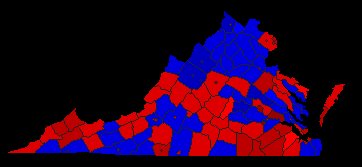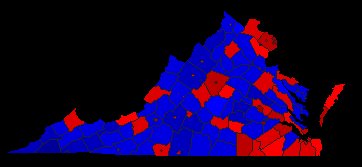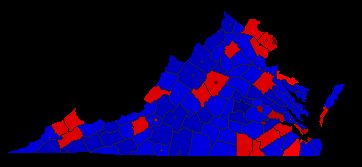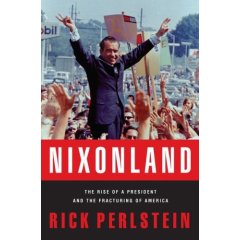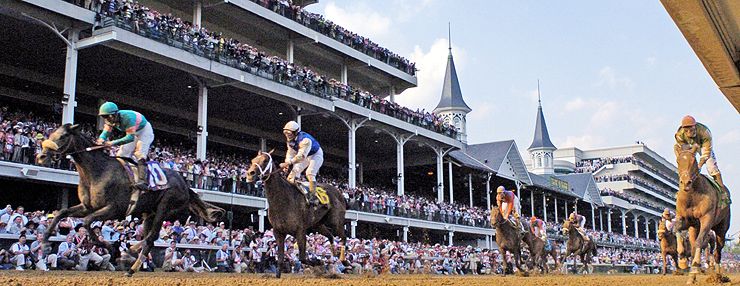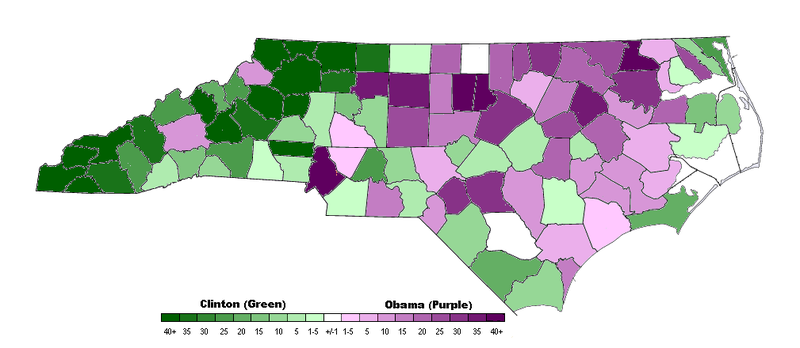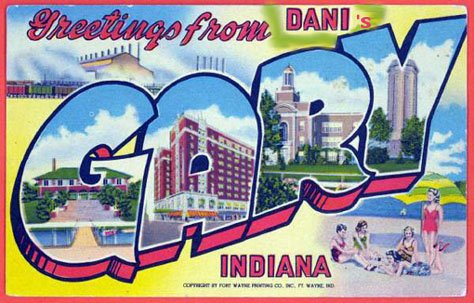Today should see Senator Clinton run up a big victory in West Virginia. Demographically, the state seems perfectly suited to her and not well suited at all for Obama, given the patterns we've seen to this point. Much has been written in the past weeks about Obama’s difficulty in winning white working class voters. The results in Ohio and Pennsylvania not only demonstrated these voters’ support of Senator Clinton, but many have put these results within a broader geographic discussion. As I mentioned in an earlier post, the “Pennsyltucky” or
“Appalachian” voting patterns not only have had an effect on the nomination contest, but will perhaps have ramifications in the general election should Obama head the Democratic ticket (an excellent discussion of this
here). Today’s contest will fill in a big chunk of the Appalachian map.

I have long been interested in how geography might affect political behavior. As I wrote in one of
my posts on the Mississippi primary, one thing that characterizes that state’s political history is a linkage between the land, the economy it fostered, the populations that worked it, and the political behavior of those groups to this day.
In fact, arguments of this type infused Kevin Phillips’ “The Emerging Republican Majority.” His discussion of settlement patterns, cultural heritage, etc. showed us that the political behavior we see today has its roots in distant history. Different regions, with different histories, populations, and economies, produce different types of politics.
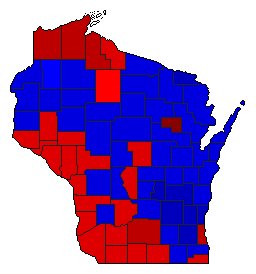
In thinking about all of this, I thought I’d look at a geographic area that has always interested me. As a student of Wisconsin politics and voting behavior, I’ve come to believe that to understand the success of Democratic candidates in the Badger state, one shouldn’t focus on the usual or obvious suspects---the population centers of Milwaukee and Madison. While these two cities provide the lion’s share of the Democratic votes in the state, to be sure, they are rarely enough to guarantee victory. Winning Democrats need to find votes outstate as well. Where they tend to find these voters is in the string of counties that border the Mississippi River in the southwestern part of the state (
see this old post).
Thinking about Wisconsin and Mississippi—two states as different as can be imagined—we see a common characteristic—river counties, namely Mississippi River counties, that are heavily Democratic. Note that on the maps above, Democratic counties are colored red; Republican counties blue. How do we explain this???
In pondering this for a few days, I began to wonder whether it was something about the river itself that explained its politics. Does geography explain politics?? As I contemplated this, I remembered an argument I’ve heard in recent years about why Democrats tend to do better on the “coasts.” Looking at electoral returns over the last several cycles, one sees, with the exception of the southeast coast, how the coastal areas of the U.S. are the most strongly Democratic parts of the country. The argument that I’ve heard to explain this suggests that these areas are, by virtue of their exposure to international trade, immigration, and cultural exchange, the most diverse in the country. This cosmopolitanism is also seen in high concentrations of universities, corporate headquarters, and media centers. As a result, voters in these areas are more likely to espouse liberal positions and therefore vote Democratic.
If this is true, might we see a similar dynamic in another major coastal area in the U.S., namely along the Mississippi River? We tend not to think about how an “inner coast” like this might be similar to the ocean fronting coasts, but in many ways—especially if we look at this historically—there are some commonalities. During the mid to late nineteenth centuries, the Mississippi River was the central artery of American commerce, linking the interior of the country with foreign export markets via the ports in and around New Orleans. Even today, the
Port of South Louisiana is the largest in the United States. Also during this earlier period, Mississippi river hubs were linked to the eastern states via the growing railroad network crisscrossing the country. Thus, in connecting disparate parts of the country the river brought different people, cultures, and economies together, creating a greater degree of cosmopolitanism and diversity than in the more inland areas.
So, have there been any political manifestations of this over the course of our history? Looking at the stretch of the River from Minnesota to Louisiana, we don’t see one party dominate the entire route by winning every state in a given election. Rather, there appears to be, especially in the elections after the Civil War, a regional dynamic—also highlighted by Kevin Phillips—in which Union/Confederate loyalties played out across these states. The northern states along the span of the river (Minnesota, Wisconsin, Illinois, Iowa) were consistently Republican, while the southern states (Louisiana, Mississippi, Arkansas, Tennessee, Kentucky) were consistently Democratic. Missouri, finding itself at the midpoint of the river was more schizophrenic in its behavior. It was Democratic until 1904, after which it became extremely competitive, to the point where it is now considered perhaps the quintessential bellwether state.
In recent electoral cycles, the entire Mississippi River area has tended to be heavily competitive, and from the Democrats’ perspective, extremely important in their attempts to win the White House. To demonstrate this, I thought it would be helpful to look a little more closely than at state maps. Instead, we can look county by county.
What we see is that, even in the years when Democrats lost the general election the counties along the river tended to vote Democratic. Below are maps for the 1988, 2000, and 2004 elections respectively (Democratic counties in Red, Republican counties in Blue). Thus, there seems to be something to the connection between the geography and its voting behavior.



I wondered next if we’ve seen any pattern to the voting this year in the Democratic primary. Indeed, we have. There are 110 counties that border the Mississippi River that have voted to this point: 17 MN; 8 WI; 18 IL; 10 IA; 17 MO; 5 TN; 6 AR; 11 MS; 18 LA. 4 Kentucky counties bordering the river will vote next week. What have we seen this year in the Obama/Clinton contest?
Of these 110 counties, Obama has won 82—75%. If we discount the homefield advantage of Obama in Illinois and Clinton in Arkansas, Obama still has a huge advantage, winning 66 counties to Clinton’s 25. Going out a level, looking at the states, Obama has won 7 of the 9 Mississippi River states. He lost Clinton's home state of Arkansas along with Tennessee, which has a short border with the river.
Beyond the overall numbers, we see a very clear pattern to the distribution of these counties. This distribution is reminiscent of the pattern I described above. Below is a map I’ve produced that shows the voting in each of these 110 counties. Obama counties are in green, Clinton counties in red. What we see, essentially, is a geographic area—the Mississippi River—that is in reality three distinct sub-regions. In the northern stretch—Minnesota to southern Illinois—Obama wins the vast majority of counties. In the southern stretch—Louisiana though Mississippi—Obama is also dominant. Clinton does best in the middle stretch—Missouri, Tennessee, Arkansas—although Obama wins a number of counties here too.

What explains this regional pattern? When I started thinking about this region a few weeks ago, I wondered if there was a racial dynamic. In examining these 110 counties, I coded the African American percentage of each. In the northern stretch, the counties are almost totally white. While Hennepin and Ramsey counties in Minnesota (Minneapolis and St. Paul) have a black population of 10% and 9% respectively, only one other county in Minnesota, Wisconsin, or Iowa has a black population above 4%. In Illinois, you have a few counties with a sizable black population (St. Clair, Jackson, Alexander) but for the most part these counties are almost exclusively white.
On the southern stretch, you see the inverse. Here, the counties have extremely large black populations. The Mississippi counties are on average 62% African American and the Louisiana counties are over 40% black (with 3 above 60%).
In the middle, and most divided stretch, you have a more moderate black population. The Missouri counties, for example, are roughly 11% black and the county with the highest black population, St. Louis city, went heavily for Obama. Clinton did win the counties in the boot heel that have relatively large black populations although she also won the northern counties of “
Little Dixie” that have small black numbers. Likewise, in Tennessee, the one county Obama won (Shelby--Memphis) has the largest black population. In Arkansas, the two counties with the largest black population, Phillips and Lee, were also for Obama while the whiter counties went to Clinton.
To expand the analysis a bit I decided to map beyond only the counties that border the river to take into account some more of the surrounding land. Below we see the map, with the general pattern described above. A fuller shading in of the states shows Clinton’s strength in Missouri and Arkansas more than when I highlighted the river counties. Also note the Edwards counties in blue, won during the Iowa caucuses.
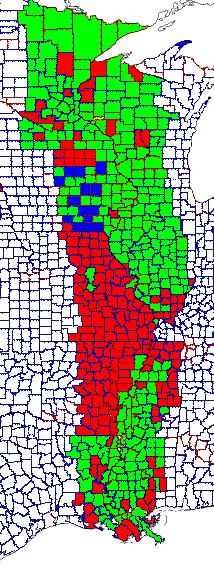
So race seems to be a factor. However it isn’t simply that Obama’s support increases as the black population increases. Rather, the dynamic seems to be more nuanced. Over the last month or so, there has been
much debate about a U shaped distribution representing the vote for Obama and the size of a state’s black population. This debate gets most interesting when we think about why the whitest states have been so heavily for Obama.
So there seems to be something going on here. I've been tossing this around in my mind for the past few weeks and have been struggling for an explanation beyond one focusing solely on race. For the northern stretch of the river, I would throw one possibility. From the outset, Obama has based his campaign on a message of “change.” More specifically, he has pledged to change the way politics is conducted and has railed against special interests, lobbyists, and the like. In many ways, this message echoes a political culture,
Progressivism, that was founded in and is well ingrained in the upper Midwest. Whether it be the LaFollette led Progressive movement in Wisconsin or the
Democratic Farmer Labor movement in Minnesota, Obama’s message seems to resonate among populations that, while demographically are very different, have a shared political heritage that jibes with his message. Looking at current polling, Obama is performing better against McCain than Hillary Clinton in these states (see
here to compare Clinton and Obama versus McCain). This, perhaps suggests that this part of the country is not just important to Democrats, but might be more prone to go Democratic with Obama heading the ticket.
So, while we might not say that Clinton's "Mississippi River Problem" isn't as severe as Obama's "Appalachian Problem," there do seem to be some worrisome signs for her, especially on the northern stretch. We can be sure that come November these states along the Mississippi River will be highly competitive. As the Democratic nomination begins to wind down, it seems as if Senator Obama is perhaps better positioned to take advantage of the politics that this stretch of land creates.
